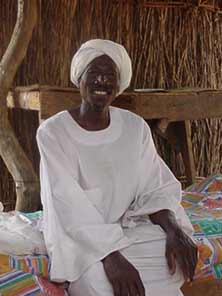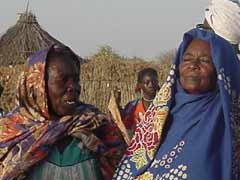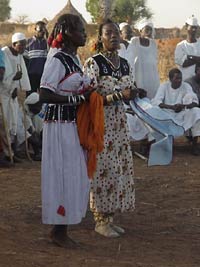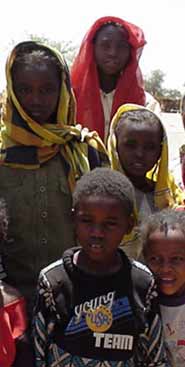


Location:
Numbering over one million, the Baggara are the second largest people group in Western Sudan, extending into Eastern Chad. They are primarily nomadic cattle herders and their journeys are dependent upon the seasons of the year. Other Baggara family groups, being the minority of the two, have settled in larger villages or cities.Identity: Baggara is actually a collective name applied to the separate cattle-herding tribes of Sudan and eastern Chad. The Baggara peoples identify with their tribal names more often than with the all-encompassing term ‘baggara.’ There are at least seven principal tribes which include the following: Humr/Messiria, Rizaygat, Shuwia, Hawazma, Ta’isha, and Habbaniya.
History:
These nomads originated from the Guhayna group, a clan of Bedouin Arabs who
poured across the Senai Peninsula from Saudi Arabia and eventually successfully
invaded the Nile region of upper Egypt and surged into The Sudan in the year
1504. After a time, the Baggara branched off from the large ‘Guhayna’ clan
and took their name because of their newfound opportunity to herd cattle in the
savan na
region of the Sahara Desert. (The Arabic word for ‘cow’ is ‘baqqara.’)
After staking their claim on the land, they intermarried with the Africans who
originally inhabited these regions, thus giving them their dark skin.
na
region of the Sahara Desert. (The Arabic word for ‘cow’ is ‘baqqara.’)
After staking their claim on the land, they intermarried with the Africans who
originally inhabited these regions, thus giving them their dark skin.
Religion:
Although their practices most closely resemble that of the Sunni sect of Islam,
most of the villagers would be more accurately classified as having ‘folk’
Islamic faith. Many tribes of the Baggara believe heavily in the ‘evil eye’
and wish to protect their cattle from jealous onlookers, even within their own
villages. The presence of witch doctors is the second piece of evidence which
ties the beliefs of the Baggara to that of ‘folk’ Islam. Children who are
ill will often have either a bracelet or necklace tied to a small leather pouch
which contains Quranic verses. This is a classic example of how Islam has been
combined with the African traditional religions. The Baggara pray toward Mecca
five times a day and the children who attend school learn both reading and
writing from the Quran.
Appearance: The women wear ‘tobes,’ (a loose-fitting cover draped about the body and over the head) on a day to day basis, but they do not veil their faces. During wedding celebrations and other festivals, the younger women dress in costumes which reveal their figures and their heads remain uncovered in order to display their ornate hairstyles and feathered headbands. They dance with the men and their movements can only be associated with those of African origin. The amount of gold worn by a man’s wife during these festivals and the number of cattle within his herd are the determining factors of his prestige within the community. The men wear pristinely white ‘jallaybiyas’ (a dress-like cotton robe which reaches mid-calf) and pants underneath. The turbans for their heads are worn thicker in the villages than in the cities for better protection against the Sahara sun.
Lifestyle:
The Baggara tribes live in tents made from sticks, grass, and mats roped
together. During the time of travel, the tent materials serve a double purpose.
The bark and grass are used for padding for a more comfortable journey and to
protect the cattle from back sores. The ropes are used for attaching the loads
to the animals and to the carts, and the mats are used for both resting during
the day and to place over the ‘pitched’ tents during the night. The
migration period is usually completed in one month’s time, dependent upon the
tribe, its location, and the average rainfall in the  area.
If the intention of a family group is to settle for a time longer than six
weeks, they will begin constructing the more permanent tents which are made from
similar materials, but are more sturdy.
area.
If the intention of a family group is to settle for a time longer than six
weeks, they will begin constructing the more permanent tents which are made from
similar materials, but are more sturdy.
Work: The women and children bring water each morning from either wells or small lakes, which are made up of rain water and are used throughout the dry seasons. Baggara women are given a number of responsibilities within their communities. These include: assisting in the building of the tents and shelters, selling milk and meat in the markets, producing baskets to sell and mats fashioned from goat hair to be used for tent decorating, and lastly, they handle most of the financial matters. In addition to these, they occupy the traditional women’s role as mothers, cooks, and hostesses. The men care for the cattle and sometimes go ahead of the women during migration, taking the herds before the mosquito and tsetse fly season begins. They also build and/or repair the fences that are necessary to be placed around their water sources as well as assisting in construction of houses and shelters.
Social:
Men and women do not eat together, unless they are married. The women prepare the meals and take the food to the men’s ‘racuba,’ (place for shelter and resting) three times each day. Spending time together is a vital part of Arab community living, and for one to deny his friends or family of this time is highly looked down upon. There are few extra-marital relationships between men and women, even on a friendship level. Boys and girls are circumcised between the ages of 5 and 7 years. A festival ensues for each candidate and the child is encouraged to not cry because a ‘crier’ will forever be labeled so. The women have extreme difficulty in child labor because of the circumcision. It would be considered unclean for a woman to not be circumcised and she would not be acceptable to marry. Men are allowed to have four wives, according to the Quran, but most cannot afford to support this number. Most men have only one or two wives and a very large number of children.Political:
To many southern tribes of the Sudan,
the Baggara were once known as ‘the raiders,’ as they were and still are on
the front lines of the civil war between the North and South. Many of the
Baggara tribes were responsible for raiding Southern civilian villages, taking
women and children as slaves, and stealing property such as cattle with the non-chalaunt
dismissal that these were the “spoils of war.” Relations at this point are
said to have improved, however in most cases the damage is irreparable. Because
the Baggara, as a whole, are not an educated people, few are involved with the
political arena in the capital city of Khartoum. They have str ong
opinions about political ideas, however, these views are biased to their nomadic
living situation.
ong
opinions about political ideas, however, these views are biased to their nomadic
living situation.
As you Pray...
Pray that the Baggara people will be open to the
message of Jesus Christ, and that God would reveal
Himself through dreams and visions.
Pray that God will raise up many intercessors
to pray for the Baggara, as it is promised that
people from EVERY tribe will worship Him.
Pray for the two known Baggara believers as
they travel into other villages to share the message of Jesus and for other
workers as they go into these countries with the same message.
Pray that the Church will hear the call to love the Baggara Peoples and the other Northern Muslim tribes of The Sudan and Chad.